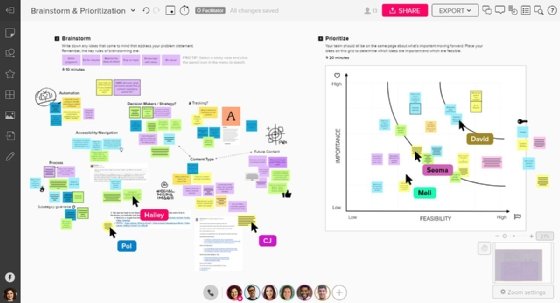
How virtual whiteboard collaboration supports remote teams
Virtual whiteboard collaboration software can help organizations replicate the in-person ideation experience. Learn how Thoughtworks used Mural's software to support remote teams.
When the global leadership team at software consultancy Thoughtworks has its annual planning meeting, it's a highly collaborative and jam-packed event. Nearly 30 company leaders from 11 countries meet to prioritize initiatives and plan for the coming year.
But when preparing for the five-day event in 2020, something unexpected happened. The COVID-19 pandemic shut down offices and froze international travel. The event had to pivot to a virtual event.
James Pickett, director of special projects at Thoughtworks, was one of the event facilitators tasked with launching the virtual meeting. Clearly, he had to get creative. The event typically involved the leadership team, physical whiteboards, interactive voting and sticky notes on walls, which can be difficult to replicate in a remote setting.
Ultimately, Pickett chose to use Mural's virtual whiteboard collaboration software as the foundation for the event. He had been using Mural for three years after a business analyst on his team introduced the software to help the team better visualize concepts compared to a physical whiteboard, he said.
Standalone virtual whiteboards are a growing area of collaboration to support remote work and provide an ideation experience that's often missing in meeting platforms. According to Metrigy's workplace collaboration study of 476 organizations, about 44% of organizations are using or planning to use virtual whiteboards, such as Mural, Miro, Bluescape and Klaxoon.
The Thoughtworks leadership planning event was turned into five three-hour sessions held over a three-week period. Using Mural, the team could vote on 16 initiatives to prioritize before each session. By integrating Mural with Zoom, the leadership team could meet in one large group and use Zoom's breakout rooms feature to meet in smaller teams and work on specific sections of a Mural whiteboard.
"It was relatively straightforward in getting the global leadership team to use Mural," Pickett said. Several members of the team had used Mural prior to the event. Overall, the response to using virtual whiteboard collaboration software for the event was positive, he added.

Virtual whiteboards support remote collaboration
In the last 18 months, as the pandemic forced Thoughtworks teams to work remotely, Pickett said he has seen widespread adoption of Mural across the company.
Before the pandemic, when teams were still working in the same location, many meetings would involve sticky notes for creative exercises or mapping out concepts on a physical whiteboard, he said. The need to collaborate this way didn't go away when employees started working from home.
"The greatest challenge Mural has solved has been to create a virtual workspace for ideation," he noted.
Pickett said the virtual whiteboard collaboration features he uses the most are sticky notes and voting, for both the initial brainstorming session and for prioritizing concepts after a session. He also uses Mural with other collaboration tools, particularly Zoom. During a Zoom meeting, Pickett can provide participants a link to a Mural whiteboard in addition to sharing the whiteboard using Zoom's desktop sharing feature.
"We have a virtual collaboration space that we can work on independently and collectively see the screen being shared via Zoom," he said.
Pickett said he believes Mural will continue to be an important collaboration tool for teams at Thoughtworks, even as they return to the office.
"If there are teams split between in person and virtual, an online collaboration space will continue to be the likely place for collaboration to ensure everyone can participate equally," he said.
Potentially, teams could use Mural even when they're all in the same physical location, as many employees have grown accustomed to working in a virtual collaboration space that can be shared and distributed after a meeting, he said.






